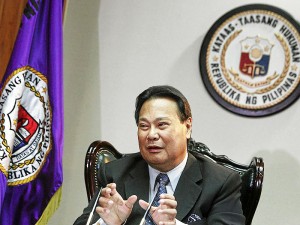MANILA, Philippines — Chief Justice Renato Corona has allowed the live video webcast of the Maguindanao massacre trial, a spokesman for the Supreme Court said Tuesday.
Public Information Chief and Court Administrator Jose Midas Marquez said they woukd restructure the Supreme Court website and acquire technical requirements to be able to follow the instructions of the Chief Justice.
“With this, the Maguindanao massacre trial will be accessible to viewers worldwide, continuously and without interruption. Once a scheduled trial is in progress, it can be immediately viewed by simply accessing the SC website (https://www.sc.judiciary.gov.ph) using computers or mobile internet devices,” Marquez said.
“Hopefully, with the live webcast, the objections regarding no commercial breaks or gaps and continuous broadcast of entire proceedings will be addressed,” Marquez said.
Last week, the high court allowed the petition of some media groups and families of the victims to have a live radio and television broadcast of the Maguindanao massacre trial subject to several conditions.
The guidelines are:
1. An audio-visual recording of the Maguindanao massacre cases may be made both for documentary purposes and for transmittal to live broadcast broadcasting;
2. Media entities must file with the trial court a letter of application, manifesting that they intend to broadcast the audio visual recording (AVR) of the proceedings; no selective or partial coverage shall be allowed and no media entity shall be allowed to broadcast the proceedings without an application duly approved by the trial court;
3. A single fixed compact camera shall be installed inconspicuously inside the courtroom to provide a single wide-angle full-view of the sala of the trial court;
4. No panning and zooming shall be allowed to avoid unduly highlighting or downplaying incidents in the proceedings;
5. The broadcasting of the proceedings for a particular day must be continuous and in its entirety;
6. No commercial break or any other gap shall be allowed until the day’s proceedings are adjourned, except during the period of recess call by the trial court and during portions of the proceedings wherein the public is ordered excluded;
7. The proceedings shall be broadcast without any voice-overs, except brief annotations of scenes depicted therein as may be necessary to explain them at the start or at the end of the scene;
8. No repeat airing of the AVR shall be allowed until after the finality of judgment, except brief footages and still images derived from or cartographic sketches of scenes based on the recording, only for news purposes, which shall likewise observe the sub judice rule and be subject to the contempt power of the court.
